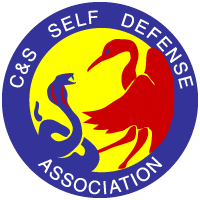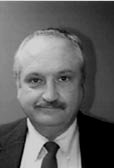
|
C&S Online
An Online Newsletter For The
C&S Self Defense Association
Spring 2004
Confidence. Fitness. Success.
|
|
Thoughts From The Board of Directors...
|

|

|
Alive & Kicking
Grandmaster Paul B. Dusenbery
|
|
Mastership
Think about this famous quote:
"There is a flow in the Universe - in Nature. Our task is to join it."
The journey to mastership is a long and difficult one but it also is
rewarding, very rewarding. As in all that we do in our Art, it is not
the end that matters but the process that we go through that is most
enlightening. The process that makes one a Master is multi-faceted. It
forces one to have the courage to look both inside and outside of
oneself to discover the secrets of nature and to be able to look the
"Tiger in the Eye." To face your personal fears is not pleasant but it
is an important responsibility of this rank.
Welcome to the Master Ranks, Master Vinciguerra.
What is a Master and why would one want to be one?
A master understands success. As Napoleon Hill said, success comes to
those who become success conscious. Success in all its various forms
including financial (understanding money), interpersonal (understanding
people), and even philosophical (understanding the principles of
nature). To be a success, a Master must take responsibility. Each of us
as individuals must take responsibility for what we have done in the
past. It thus follows naturally that we must begin to take
responsibility for what we are to become in the future. As Grandmaster
Rose says, "We live for today but we plan as though we will live
forever. Responsibility is a key tenet of our Art.
A master is a warrior: one who understands violence & beauty. One who
can take decisive action in their pursuit of truth. One who has
courage,
honor, and character. One who does not let fear get in the way. One who
believes in himself. One who has a passion for life and has purpose for
being here.
Congratulations Master Vinciguerra.
I could write many more pages about the rank that you recently achieved
because it means so much to me and my colleagues. You are now one of
us. Your chapter is just beginning. What will you write? What will be its
content? How will your life continue to positively impact others? You
will now have the opportunity to answer these and many more questions
about your journey through mastership. Make us proud.
Lastly,
"If there is righteousness in the heart, there will be beauty in the
character.
If there be beauty in the character, there will be harmony at home.
If there be harmony in the home, there will be order in the nation.
If there will be order in the nation, there will be peace in the
world."
Confucious
It all begins with each of us. Let's get started!
Grandmaster Paul B. Dusenbery, PhD holds a 7th Degree Black belt. He began his studies with Grandmaster Rose in 1972. Dr. Dusenbery is a space scientist, writer, lecturer, and is the Executive Director of the Space Science Institute in Boulder, CO. He oversees the Dusenbery Tiger leg of C&S. Grandmaster Dusenbery can be reached at dusenbery@spacescience.org.
Top | Front Page | Board | Featured | Happenings | Views | Back Page | C&S Home
|

|

|
The Dragon's Tail
Grandmaster David R. Landers
|
|
Our Bodies As Our Textbook
If you hang around me long enough
you will undoubtedly hear me say that the Martial Arts are encompassed, in all but a small area of the discipline, in three major sciences: Physics, Anatomy, and Psychology. What I mean to say is, that to deeply understand the hows and whys of the Art we must have some working knowledge of these areas of study. I hear lots of talk about specific techniques and how they are delivered and what they are supposed to do and have heard these discussions in many disciplines and styles over many years. Much of what I hear is just so much hot air. How are we to judge the efficacy and proper delivery of our techniques if so much of it is just secondhand hot air from years of misunderstanding and guesswork? Go back to your study of Anatomy and of Physics and, most of all, observe your body and how it moves.
One area that is fraught with misunderstanding is the front kick. Most styles teach the front kick as a "hinge kick" in which the knee is brought up and then the lower leg and foot are extended. We are often told that the string point is the ball of the foot, this is wrong. I can't retract my toes that far and neither can you. If the kick is delivered to the more or less vertical torso of the opponent, the toes will always hit first and the blow will always glance. This hinge kick is for the head or face, once the opponent is bent over, or if you have the flexibility to kick head-high. At that height the ball of the foot may in fact be used as a striking point. For torso kicks the only way to use the ball of the foot is for the knee to travel down in relationship with the foot. I have had to kick down lots of doors in my time and I can tell you, can't hinge kick them. The closer your knee is to your chest prior to execution, the harder you will kick.
A corollary to this discussion is the roundhouse kick. The roundhouse hinge or snap kick is not, again, a ball of the foot kick but an instep kick. Don't trust what I'm saying about this, I told you that there is much hot air out there, go kick things and see who is right. After you crunch your toes enough you will agree with me. We throw 3 kinds of roundhouse kicks: the snapping hinge type instep kick, the thrusting roundhouse (delivered like the thrusting front kick) and the dead-legged Muy-Thai style shin kick.
Punches are also the subject of lots of discussion. Punches thrown with the palm facing down (hand turned over punch) simply cannot lock with the torso sufficiently in all but the very muscularly developed, to fully utilize the twisting power of the hips and thus the body's weight. That doesn't mean you can't punch that way at all, it just means that you won't transfer the full power of your body with that position because it unlocks your pectoralis muscles. Boxers use this type of punch in the form of the jab and the overhand punch. These can be effective but the real power punches in boxing are from uppercuts and crosses. In these punches the fist is aligned with the bicep. You see it's not whether the palm points toward the ground, but whether it points toward the bicep that determines the way the power is generated. The best punch for the torso is the three quarter turned fist which also presents the first knuckle as the striking surface. Don't overturn the fist (making the palm parallel with the ground) as this tends to unlock the bicep and puts strain on the wrist. When the bicep is engaged, it reinforces the lower arm and fist, and the pectorals then lock the entire arm to the torso allowing the full turning energy of the back and the legs to transfer energy into the opponent. Tate punches are an advanced punching technique and are not really just short body punches as is sometimes taught. Deeper study into the Tate reveals that they are always taught as being delivered with the wrist cocked down and the elbow bent. I feel the true use of the Tate is for "sinking punches" delivered to the torso and chest with the energy always directed down to the chi center. These are very dangerous punches and should not be practiced indiscriminately on others.
Finally, for now, let's address the shuto hand. There are 2 main shuto hands that we practice. The first is the "curling shuto hand" which is used to strike the clavicle and ribs. The first 2 fingers of the hand a very slightly curved and the last 2 are much more strongly tucked into the palm. This hand raises the muscles on the area of the hand just above the wrist and make it ideal for hammering strikes. The other hand is the "knife hand shuto" a very old technique in which the first to 2 fingers are again gently curved in toward the palm and the last 2 fingers are extended straight out. This raises a knife edge all along the edge of the hand and is used for knife hand strikes to the neck and throat.
The best way for you to analyze techniques is to think about what you are going to hit, what effect you desire, and how that can best be delivered. You may not agree with all my conclusions but do your own homework before you decide.
Master David R. Landers holds a 6th Degree Black belt. He began his studies with Grandmaster Rose in 1969. He served as Deputy Chief of Police of Effingham, Illinois from 1997 to 2000 when he assumed the role of Illinois State Field Coordinator for the Midstates Organized Crime Information Center. He oversees the Landers Dragon leg of C&S. Master Landers can be reached at candsdragon@mchsi.com.
Top | Front Page | Board | Featured | Happenings | Views | Back Page | C&S Home
|
Website design by Peter Rose, zzrose@yahoo.com
|


